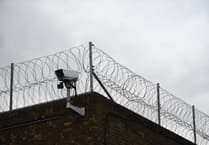AS all fans of Game of Thrones will know, the Red Wedding massacre is one of the most memorable parts of George R. R. Martin's books and TV adaptation.
The unexpected slaughter of the King in the North Robb Stark and his defenceless men by the bloodthirsty minions of the duplicitous Lord Walder Frey and Lord Roose Bolton was a turn of events that took everyone by surprise.
The fact that Stark, his mother Catelyn, and their armless men-at-arms were all wedding guests when they were slain in cold blood was an act of treachery that turned everyone’s stomach.
Yet such unbridled savagery and blatant backstabbing were par for the course in the days when men rode big horses and hacked each other to pieces with sharp swords, hefty axes, and murderous maces.
Most people in Abergavenny will be familiar with a similar incident that happened within the foreboding ruins of the town’s castle back in 1175.
The question is, how much did the notorious Christmas Day massacre at Abergavenny Castle influence George R. R. Martin? When it came to writing the Red Wedding scene?
The famous fantasy author once wrote, “No matter how much I make stuff up, there’s stuff in history that’s just as bad, or worse.”
With that in mind, let’s check out the facts!
Wales has the highest concentration of castles in Europe. Estimates suggest Cymru was home to over 600 of these bastions of stone and oppression.
The Normans have been described as "colonists of genius," and they went all out to crush any Welsh opposition by fair means or foul.
There is an infamous tale surrounding Abergavenny Castle which illustrates this to perfection.
One Christmas Day in 1175, the lord of the manor, one William de Braose, fondly remembered as the Abergavenny Ogre, kindly invited all the local Welsh Chieftains to a festive knees up at the town’s castle.
Willing to put aside years of bloody conflict, the Celts happily accepted the Norman lord’s invite, and led by Sitsyllt ap Dyfnawl, the Welsh lads turned up expecting to share a few gallons of ale and make merry with the boys from France.
Except the only thing on the menu that night was carnage, and lots of it.
After politely leaving their swords, axes, and spears at the door, Sitsyllt and his crew took their seats at the table in the Great Hall, picked up their goblets of mead and looked forward to the hog’s heads, roast swan, and other Norman delicacies on offer, but things turned sour quicker than a lump of stilton cheese in the microwave, when Lord Willy announced that he had recently decided that from that day on no Welshman should have the right to bear arms, so there.
As you can imagine, this little revelatory nugget sat in the stomach of the gathered assembled about as well as an undercooked chunk of rotten fish, but before they could protest, or beat the living daylights out of Willy for his brass-necked audacity and poor etiquette, it all went to hell in a handcart.
At a curt pre-arranged nod of the head from William de Braose, the time-honoured bond between visitor and guest wasn’t so much broken but ruthlessly torn apart, as a horde of soldiers led by the Sheriff of Hereford, Ranulph Poer, descended upon the unarmed and shell-shocked Welshman and butchered every last one of them in a gleeful savagery. All that is except Prince Iorwerth of Caerleon, who is said to have wrestled a sword from a witless Norman and hacked his way through the throng to liberty and life.
Not content with such a massacre, the bloodthirsty butcher Braose saddled up a posse of his men the very next day and once again went on the rampage. This time, they went to Sitsyllt’s home, where, in front of his widow, they killed his seven-year-old son Cadwaladr.
Such treachery and psychopathic behaviour earned de Braose a defining role in Abergavenny’s history. The belligerent brute nearly got his just rewards in 1182 when the sons of the slaughtered Welshmen came of age and stormed the gates of Abergavenny Castle, killing the entire garrison, but to their disappointment, de Braose and his wife Maud were elsewhere.
Wicked Willy continued to narrowly escape justice for his diabolical deeds, and he was never dealt retribution by a Welsh hand. Instead, he fell out of favour with King John and, after having all his castles seized, he fled to Ireland with his family, where his wife and eldest son were captured by the King’s men and starved to death at Windsor Castle, such was the niceties of Norman nobility.
As for the Abergavenny Ogre, he fled to France disguised as a leper, where he died on August 9, 1211. An ignoble end to a wretched creature.
Now what of the fictional butchering of the Starks in the Red Wedding episode of Game of Thrones?
The backstory to the carnage is one of revenge by the Lannisters and Lord Walder Frey. If you want to know more, binge the show because winter is coming!
As the scene unfolds, all is merriment, joy, and dimly lit and atmospheric interiors as the groom kisses the bride and the band plays on.
Yet when a mysterious figure suddenly closes and bars the door of the great feasting hall, you can tell by the look on Robb Stark’s mother’s face that something is up.
The fact that the band starts playing something resembling a funeral dirge is a bit of a giveaway, and before you know it, it’s time for Lord Walder to make a speech to Robb Stark about being remiss in his duties and not showing the assembled guests the hospitality they deserve.
Next thing we know, the knives come out, throats are cut, pregnant women are butchered, and the archers mow down the defenceless guests.
Everyone dies!
Much like the massacre at Abergavenny Castle, it is unexpected, brutal, cowardly, and extremely upsetting to our innate sense of justice.
Here’s the rub!
Although in theme, tone, and setting, the slaughter is extremely reminiscent of what went down at Abergavenny Castle, George R.R. Martin has previously explained that the inspiration for the show’s shocking Starkicide was actually based on two grimly fiendish events from Scottish history.
The first up was the Black Dinner of November 1440, when the 16-year-old 6th Earl of Douglas and his little brother were invited by Sir William Crichton of Clan Crichton for a spot to eat at Edinburgh Castle with the ten-year-old King James II of Scotland.
Because they were seen as a political threat to Crichton, the dinner date was a ruse, and the Douglas brothers were dragged outside, given a sham trial where they were found guilty of high treason, and executed.
The second event in Scottish history was the Massacre of Glencoe, which we do not have the time or space to discuss in great detail here. Needless to say, it involved an uppity King, a twist of treachery, and a sprinkle of slaughter.
Times were tough back in the day when swords were sharp and treachery was a way of life. However, no matter what George R.R. Martin says, the Red Wedding slaughter seems a lot closer in spirit to the Abergavenny Castle massacre than any of the two Scottish incidents.
So on the strength of that alone, we’ll claim it as the real, real-life inspiration for a scene that screams betrayal louder than bombs and packs more attitude than an apocalypse!




Comments
This article has no comments yet. Be the first to leave a comment.